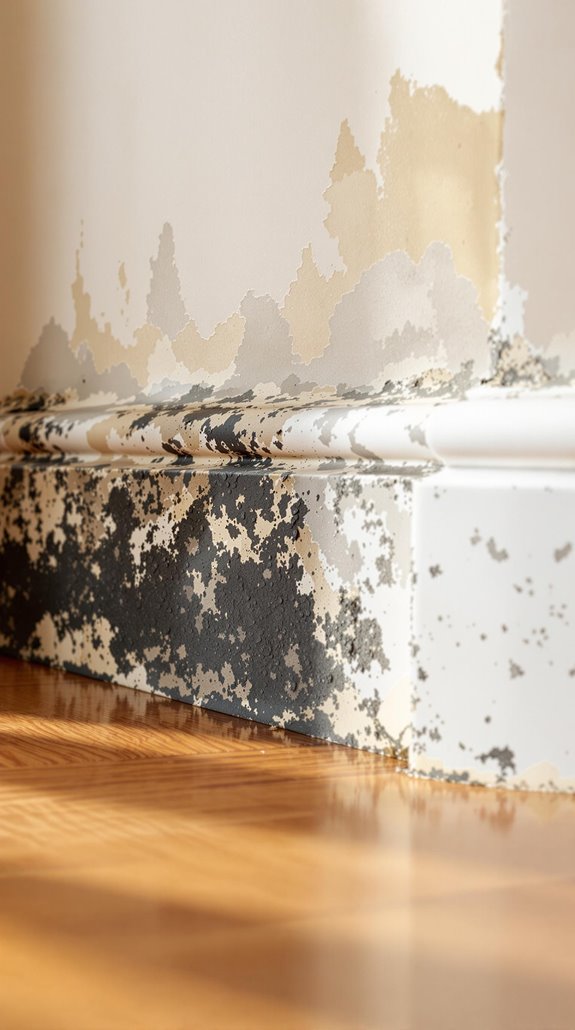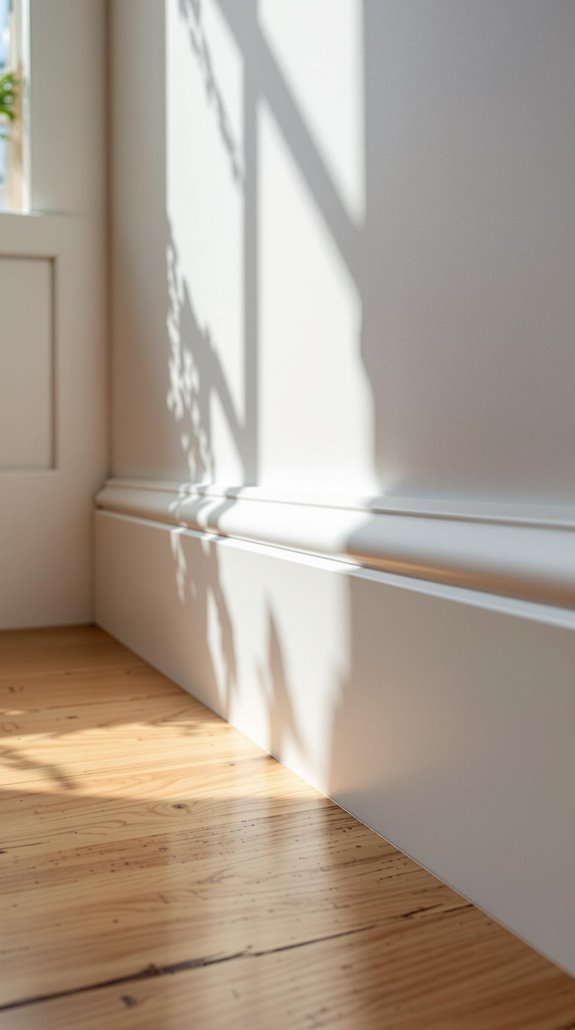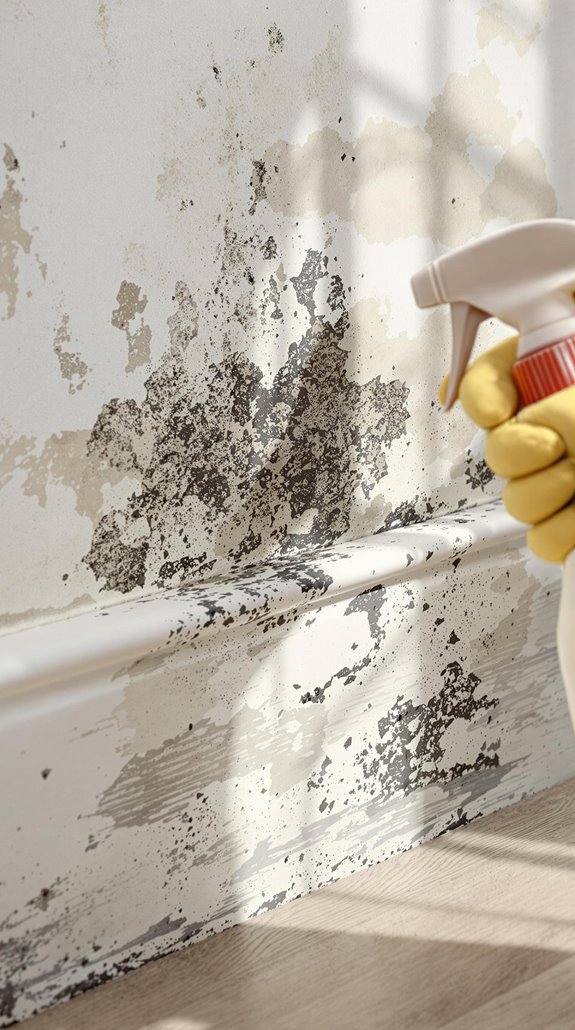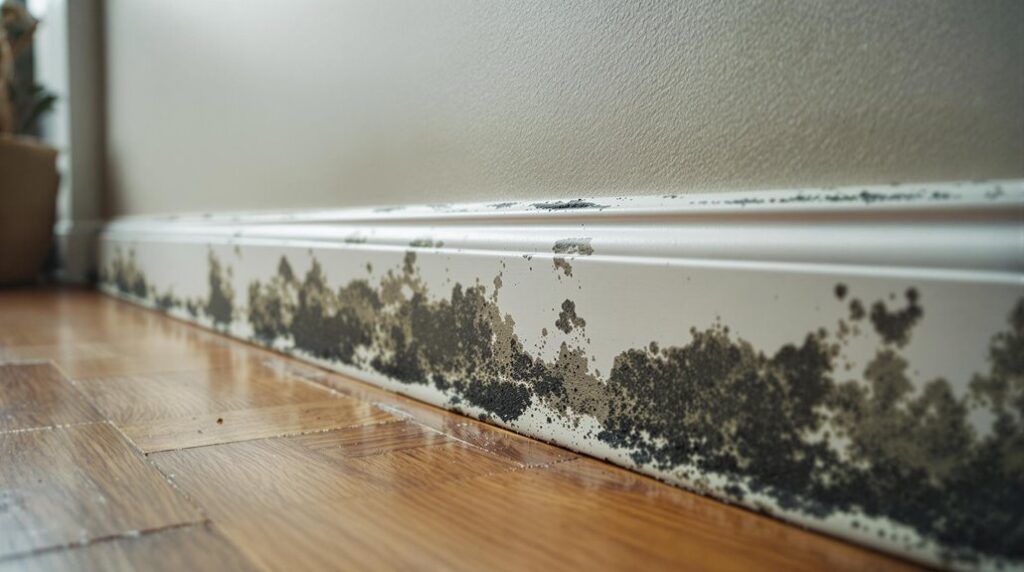I’ve dealt with countless UK homes where mould creeps along skirting boards, turning what should be clean edges into unsightly black streaks. You’re likely here because you’ve spotted those telltale dark patches, and I’ll tell you straight—this isn’t just about aesthetics. The dampness causing this mould threatens your health and your property’s value. I’ll show you exactly how to tackle this problem using specific tools and techniques that actually work, starting with what’s really happening behind those boards.
Key Takeaways
- Increase ventilation by opening windows daily and using extractor fans to reduce moisture buildup that causes mould growth.
- Clean existing mould with vinegar solution or bleach mixture while wearing protective gear for safe removal.
- Apply anti-mould paints to skirting boards and maintain indoor humidity below 60% using dehumidifiers.
- Keep furniture away from external walls to improve airflow and prevent condensation on cold surfaces.
- Seek professional diagnosis for persistent damp issues requiring damp-proof course injection or structural repairs.
Why Mould Appears on Your Skirting Boards

When warm, humid air hits your cold skirting boards, you’re looking at the perfect storm for mould growth. I’ll explain what’s happening in your home so you can tackle this head-on.
Your daily activities – cooking, showering, even breathing – pump moisture into the air. When this humid air meets cold surfaces like skirting boards against external walls, condensation forms instantly. Add poor ventilation, and you’ve trapped that moisture exactly where mould thrives. Additionally, installing driveway soakaways can help manage excess water around your property, reducing the likelihood of moisture issues.
If you’ve got rising damp or water penetration issues, your skirting boards are absorbing moisture from below and behind. MDF skirting boards are particularly vulnerable – they’re like sponges for dampness. In older homes, modern building materials can actually trap moisture that traditional materials would have allowed to escape naturally.
The dust and dirt that naturally accumulates on skirting boards becomes mould food, completing the recipe for those black spots you’re seeing. Check that your external ground levels sit lower than your indoor floor levels, as elevated ground outside can push damp directly into your home’s structure.
Health Hazards and Property Damage From Skirting Board Mould
Because mould on your skirting boards poses serious threats to both your health and property, you need to understand exactly what you’re dealing with before tackling the problem.
I’ve seen firsthand how inhaling mould spores triggers allergic reactions, asthma attacks, and respiratory conditions. Toxic black mould is particularly dangerous—it can cause sick building syndrome or even fatal asthma attacks. Children and elderly family members face heightened risks. Early detection is crucial to mitigate these dangers.
Your property suffers too. Mould causes skirting boards to warp, twist, and detach from walls. MDF boards rot completely, requiring costly replacements. The damp spreads to adjacent walls and flooring, compromising structural integrity. Rising damp often leaves distinctive tide marks on affected walls whilst causing paint and plaster to flake around your skirting boards.
Don’t wait—delaying action worsens both health risks and property damage, turning manageable repairs into expensive renovations.
Preventing Mould Growth Before It Starts

Prevention beats cure when it comes to mould growth—I’ve learned that stopping moisture problems before they start saves both money and health complications.
I’ll share the game-changing strategies that work. Open your windows daily for air exchange, even briefly. Run extractor fans during cooking and bathing, then keep them running afterward. Install whole-house ventilation systems if you’re serious about long-term solutions. Maintaining good ventilation is critical for achieving a high EPC rating.
Control humidity ruthlessly. Dry laundry outdoors when possible, use dehumidifiers in damp areas, and keep indoor humidity below 60%. I recommend buying a hygrometer to monitor levels.
Maintain consistent low-level heating to warm wall surfaces. Position furniture away from external walls for airflow. Apply anti-mould paints to vulnerable areas like skirting boards. Always use pan lids while cooking to minimize water vapour production. These proactive steps prevent mould colonies from establishing themselves.
Effective Cleaning Methods to Remove Existing Mould
Four proven cleaning methods can eliminate existing mould from your home—I’ve tested each one extensively and know which works best for different situations.
Vinegar solutions work brilliantly for most mould types. I mix equal parts white vinegar and water, spray directly onto affected areas, and let it sit for one hour before wiping clean. For stubborn patches, I use neat vinegar without dilution.
Bleach methods excel on non-porous surfaces. I combine one part bleach with four parts water, scrub gently with a cloth, then wipe away residue immediately. Always wear eye protection when using bleach sprays to prevent irritation.
Commercial mould removers like HG Mould Spray offer convenience—just follow the manufacturer’s instructions precisely.
Baking soda pastes protect delicate surfaces. I create a thick paste using two parts baking soda and one part vinegar, apply for one hour, then scrub thoroughly.
Professional Solutions for Persistent Damp Problems

While cleaning existing mould tackles the visible symptoms, some damp problems run deeper than surface treatments can reach. I’ve learned that persistent damp issues require professional diagnosis to identify whether you’re dealing with rising damp, penetrating moisture, or condensation problems. Surveyors do look for signs of damp, but the extent of their inspection depends on the survey type chosen(types of surveys).
Professional surveys using infrared technology and humidity readers will pinpoint the exact cause. You’ll need chemical damp-proof course injection for rising damp, or cavity wall membrane systems for thorough moisture barriers. For condensation issues, Positive Input Ventilation (PIV) units provide targeted airflow control.
Structural repairs might include stripping contaminated plaster and installing damp-proof membranes. Professional solutions come with 30-year guarantees on workmanship, ensuring your investment protects your home’s structural integrity long-term. Property Care Association approved contractors ensure the work meets industry standards and provides additional peace of mind for homeowners.
Conclusion
I’ve shown you the tools and methods to tackle mould on your skirting boards head-on. You’ll need proper ventilation, dehumidifiers, anti-mould paints, and regular cleaning routines to keep dampness at bay. Don’t let minor mould issues escalate into major problems. If you’re dealing with persistent dampness despite these fixes, I’d recommend calling in professionals immediately. Your health and property value depend on swift action—implement these solutions today.
References
- https://www.icecleaning.co.uk/blog/how-to-get-rid-of-mould-on-skirting-boards
- https://www.homebuilding.co.uk/advice/mould-on-skirting-boards
- https://dampsurveyorsltd.com/how-to-treat-damp-skirting-boards/
- https://www.cse.org.uk/advice/condensation-damp-and-mould/
- https://www.adur-worthing.gov.uk/housing/conditions-and-empty-properties/damp-and-mould/
- https://www.envirovent.com/help-and-advice/why-ventilate/mould-problems/how-to-stop-mould-growing-behind-furniture/
- https://forums.moneysavingexpert.com/discussion/5957543/green-mould-on-new-mdf-skirting
- https://national-claims.co.uk/different-types-of-damp-and-mould-and-their-negative-impact/
- https://www.gov.uk/government/publications/damp-and-mould-understanding-and-addressing-the-health-risks-for-rented-housing-providers/understanding-and-addressing-the-health-risks-of-damp-and-mould-in-the-home–2
- https://paintersworld.co.uk/painters-advice/the-best-anti-mould-paint

